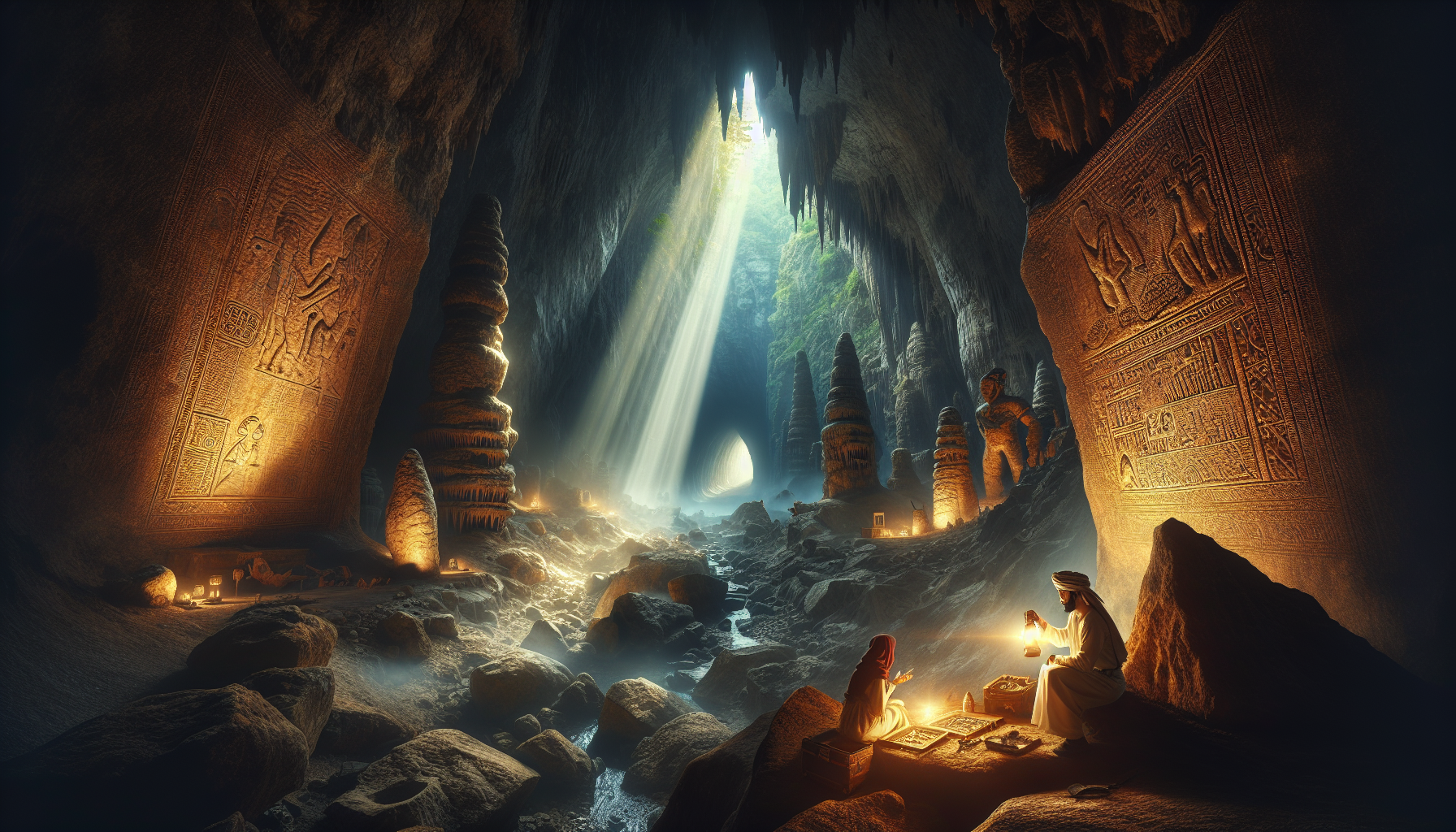Beneath the surface of our planet lies a hidden world, a labyrinthine network of passageways and chambers that have captured the human imagination for centuries: caves. These subterranean marvels are more than mere geological formations; they are time capsules, offering a glimpse into the ancient past and serving as reservoirs of history, biology, and anthropology. But what if we told you that caves are much more than dark, mysterious voids beneath our feet? They are, in fact, ancient memory chambers, holding the keys to understanding the evolution of our planet and the species that inhabit it. 🌍
Caves have been a part of human folklore and fascination for as long as we have existed. They evoke a sense of mystery and wonder, often appearing as settings for myths and legends. However, their true value lies not just in their enigmatic allure, but in the wealth of information they contain. From the delicate formations of stalactites and stalagmites that take thousands of years to form, to the ancient fossils and prehistoric art that adorn their walls, caves serve as nature’s own archives, chronicling the history of our world in intricate detail. 🕵️♂️
This article invites you on a journey to uncover the secrets hidden within these natural vaults. We will delve into the role caves have played throughout history, serving as shelters, ceremonial sites, and even as cradles of early human civilization. We will explore how these subterranean spaces have preserved invaluable records of climate change, offering insights into past environmental conditions that can inform our understanding of current and future challenges. Furthermore, we will examine the biodiversity found within cave systems, highlighting the unique and often fragile ecosystems that exist in isolation from the world above. 🌿
Join us as we navigate through the depths, shining a light on the myriad wonders of cave systems and their significance as ancient memory chambers. From the captivating tales of their discovery to the cutting-edge science being conducted within their depths, caves continue to reveal the secrets of our planet and its history. Whether you are a seasoned speleologist or simply someone with a curious mind, this exploration promises to enrich your understanding of the world beneath our feet and the stories it has to tell. Prepare to be amazed by the hidden treasures and timeless narratives that lie just beneath the surface. 🗝️
The Enigmatic World of Cave Systems
Caves have always been a subject of fascination, both for their mysterious allure and their scientific significance. These natural underground chambers serve not only as habitats for unique ecosystems but also as repositories of ancient human history. From the earliest times, caves have acted as shelters, places of worship, and repositories of art and records, making them essential for understanding our past. Their stable environment, shielded from the elements, has preserved artifacts and markings that offer insights into the lives and beliefs of our ancestors. 🌍
The study of cave systems reveals a world rich with geological formations and biological diversity. Speleologists and archaeologists have spent decades exploring these underground marvels, unraveling secrets that range from geological processes to prehistoric art. Caves are formed through a variety of natural processes, primarily the dissolution of limestone by acidic water, leading to the creation of intricate networks of passageways, chambers, and formations like stalactites and stalagmites.
These environments are home to a range of organisms adapted to life in darkness, such as blind fish and unique fungi. This biodiversity is crucial for scientists seeking to understand evolutionary processes and the adaptability of life forms. Moreover, caves play a vital role in hydrology, acting as natural reservoirs and influencing water cycles in their regions.
Table: Geological Formation of Caves
| Process | Description |
|---|---|
| Dissolution | Acidic water erodes limestone, creating underground voids. |
| Lava Tubes | Formed by the flow of lava beneath a hardened surface. |
| Sea Caves | Created by the mechanical action of waves on coastal cliffs. |
| Glacial Caves | Formed by meltwater beneath glaciers. |
For a visual understanding of these processes, watch this detailed video by the “National Geographic” channel.
Caves as Ancient Memory Chambers
Caves have served as more than just natural wonders; they are ancient memory chambers where humanity’s past is etched into stone. From prehistoric cave paintings to sacred rituals, these spaces hold immense cultural and historical value. The walls of caves like Lascaux in France and Altamira in Spain are adorned with stunning Paleolithic art, depicting animals, human figures, and abstract signs. These artworks, dating back tens of thousands of years, provide invaluable insights into the cognitive and artistic development of early humans. 🖼️
The acoustics of caves also played a role in their significance. Many ancient cultures used caves for rituals and ceremonies, taking advantage of the natural amplification of sound. This auditory element added a spiritual dimension to these sacred spaces, where chants and music would reverberate through the chambers, creating an ethereal experience. Studies suggest that the placement of paintings often aligns with the best acoustic spots within a cave, indicating a deliberate choice by ancient artists.
Furthermore, caves have been found to contain evidence of ancient burial practices, offering clues about the beliefs and customs of past societies. These burial sites, often accompanied by tools, ornaments, and other artifacts, provide a glimpse into the spiritual life and social structures of prehistoric communities.
Key Caves with Historical Significance
- Lascaux Cave (France): Famous for its Paleolithic cave paintings.
- Altamira Cave (Spain): Known for its Upper Paleolithic paintings.
- Chauvet Cave (France): Houses some of the oldest known cave paintings.
- Cueva de las Manos (Argentina): Renowned for its stenciled handprints.
Preservation Challenges and Modern Explorations
The preservation of these ancient memory chambers poses significant challenges. Human activities, environmental changes, and tourism have all impacted the delicate ecosystems and the integrity of cave art. Efforts to preserve these sites often involve restricting access, which balances the need for scientific study and public education with the imperative of conservation. Technology plays a vital role in these efforts, with 3D modeling and virtual reality providing new ways to explore and document cave systems without physical intrusion. 🛠️
Modern explorers and researchers continue to uncover new caves and passages, adding to our understanding of both natural history and human evolution. The use of advanced equipment such as laser scanning, drones, and remote-operated vehicles has revolutionized cave exploration, allowing access to previously unreachable areas. These technologies not only aid in exploration but also in monitoring environmental conditions within caves, which is crucial for their preservation.
The collaboration between scientists, historians, and indigenous communities is also essential. Indigenous peoples have often held the knowledge of cave locations and their cultural significance, contributing valuable insights that guide preservation efforts. This multidisciplinary approach ensures that caves remain protected for future generations while continuing to serve as windows into the past.
To see a modern exploration of a fascinating cave system, check out this YouTube video from “Discovery Channel”.

Conclusion
Concluding this exploration into the enigmatic world of cave systems as ancient memory chambers, we can appreciate the profound complexity and significance these natural structures hold. Throughout the article, we delved into the historical, cultural, and scientific perspectives that underscore the importance of caves in preserving the tapestry of human and Earth’s history.
Firstly, we examined how caves have served as repositories of ancient art and symbols, offering us invaluable insights into the lives and beliefs of early human societies. These subterranean galleries not only showcase the creativity and spiritual expressions of our ancestors but also provide clues about their daily lives, rituals, and interactions with the natural world. From the mesmerizing paintings in Lascaux to the intricate carvings found in various parts of the world, caves serve as open books to the past, waiting for each page to be read and understood.
Secondly, we explored the role of caves in preserving geological and paleontological records. These natural time capsules hold the keys to understanding climatic shifts, biological evolutions, and even the dramatic events that have shaped the Earth’s surface over millennia. The stalactites and stalagmites tell tales of ancient weather patterns, while fossilized remains of extinct species offer a window into the biological diversity that once flourished. Caves thus act as crucial archives that help scientists reconstruct the planet’s environmental history and predict future changes.
Moreover, we touched on the cultural and spiritual significance of caves across various civilizations. Many cultures view caves as sacred spaces, using them for ceremonies, burials, or as places of refuge. This cultural heritage enriches our understanding of how humans have related to the natural environment and each other across different epochs and regions. Recognizing the spiritual dimensions attributed to caves encourages us to approach these natural wonders with reverence and curiosity.
Our discussion also highlighted the scientific research currently undertaken in cave environments, which extends beyond archaeology and paleontology. Caves are at the forefront of studies into extremophile life forms, which thrive in these dark, nutrient-scarce environments. Such research not only expands our knowledge of life’s adaptability but also informs the search for extraterrestrial life, offering analogs for conditions that might exist on other planets.
The ecological significance of caves as unique habitats for specialized flora and fauna was also underscored. Preserving these ecosystems is crucial, not only for maintaining biodiversity but also for ensuring the stability of broader ecological networks that support life on Earth.
As we conclude this journey through the depths of Earth’s memory chambers, it is evident that caves are not merely natural formations, but dynamic entities with profound implications for understanding our past, informing our present, and inspiring our future. The intricate interplay between natural processes and human activity found within these subterranean landscapes invites ongoing exploration and discovery.
In reflecting on the importance of this topic, it becomes clear that safeguarding cave systems is imperative. The threats posed by climate change, pollution, and irresponsible tourism necessitate concerted efforts in conservation and sustainable management. By protecting these ancient archives, we ensure that their stories and lessons remain available for future generations.
As you ponder the insights and mysteries unveiled by our exploration of caves, I encourage you to delve deeper into this fascinating subject. Engage with local conservation efforts, visit educational exhibits, or participate in guided tours to witness firsthand the wonders hidden beneath our feet. Sharing this knowledge can inspire others to appreciate and protect these invaluable natural resources.
Feel free to share this article with friends and colleagues who might be intrigued by the secrets of cave systems. Your comments and discussions can further illuminate the ongoing dialogue about the preservation and study of these natural wonders.
In closing, remember that every cave holds the potential to reveal untold stories. By championing their protection and study, we become stewards of history, ensuring that the ancient memories etched within the Earth continue to inspire and inform. 🌍🔦
For further reading and exploration, consider visiting reputable sources like the National Speleological Society (https://caves.org) or UNESCO’s World Heritage sites (https://whc.unesco.org). These platforms offer a wealth of information and resources for those eager to uncover more about the world of caves.
Toni Santos is a visual storyteller and cognitive explorer whose work delves into the mental landscapes of ancient cultures—revealing how different civilizations perceived reality, memory, and meaning long before modern psychology existed. Through symbolic imagery and narrative inquiry, Toni brings to life the divergent ways of thinking that shaped lost worlds.
His creative path is guided by a fascination with non-linear logic, oral cosmologies, and the mythic frameworks that once guided decision-making, emotion, and identity. From memory temples carved in stone to visual languages encoded in textiles, every piece Toni creates reflects the vast cognitive diversity of the human story.
With a foundation in visual design and cultural semiotics, Toni blends analytical depth with artistic expression. His work goes beyond historical reconstruction—it reawakens the embodied, intuitive, and ritual-based intelligence of ancient minds, inviting us to question the assumptions of modern thought.
As the mind behind Vizovex, Toni curates visual studies, essays, and immersive content that explore forgotten epistemologies—ways of knowing that connected people to myth, land, and each other in profoundly different ways.
His work is a tribute to:
The symbolic intelligence of pre-modern cultures
The neural diversity embedded in ancient rituals and storytelling
The deep memory systems that shaped identity and perception
Whether you’re a researcher, an artist, or a seeker of hidden wisdom, Toni invites you to enter a space where cognition is culture, and where the past speaks through signs, cycles, and symbols—one myth, one memory, one mind at a time.





